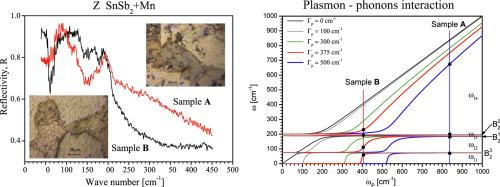当前位置:
X-MOL 学术
›
Infrared Phys. Technol.
›
论文详情
Our official English website, www.x-mol.net, welcomes your
feedback! (Note: you will need to create a separate account there.)
Plasmon - phonon interaction in ZnSnSb2 + Mn semiconductors
Infrared Physics & Technology ( IF 3.1 ) Pub Date : 2020-08-01 , DOI: 10.1016/j.infrared.2020.103345 Maja Romcevic , Novica Paunovic , Uros Ralevic , Jelena Pesic , Jelena Mitric , Jelena Trajic , Lukasz Kilanski , Witold Dobrowolski , Irina Valentinovna Fedorchenko , Sergey Fedorovich Marenkin , Nebojsa Romcevic
Infrared Physics & Technology ( IF 3.1 ) Pub Date : 2020-08-01 , DOI: 10.1016/j.infrared.2020.103345 Maja Romcevic , Novica Paunovic , Uros Ralevic , Jelena Pesic , Jelena Mitric , Jelena Trajic , Lukasz Kilanski , Witold Dobrowolski , Irina Valentinovna Fedorchenko , Sergey Fedorovich Marenkin , Nebojsa Romcevic

|
Abstract Semiconductors of II-IV-V2 type with chalcopyrite structure have been studied for several decades. Due to advances in materials synthesis technologies, and doping with various elements, the possibilities of their application have expanded. In this paper, polycrystalline ZnSnSb2 + Mn was examined with the aim to explain the connection of its high free carrier concentration with the material structure and influence on optical properties. Two samples of Zn1-xMnxSnSb2 with different compositions (x = 0.027 and x = 0.076) and significant difference in carrier concentrations were analyzed. Their structural properties were examined by x-ray diffraction, optical microscopy, and AFM. The existence of several different phases - ZnSnSb2, ZnSb, SnSb, and small amounts of Sn and MnSb, as well as very complex microstructures, were registered. It was found that the high free carrier concentrations are caused by a large number of defects, especially zinc vacancies. Optical properties were analyzed using IR spectroscopy at room temperature. Based on the analysis of IR reflection spectra, the presence of plasmon - phonons interaction was registered. It was determined that three ZnSnSb2 phonons of B2 symmetry interact with plasma, which then leads to the change of their positions. A detailed analysis of this interaction provides insight into the behavior of some other material parameters. Also, vibration modes of ZnSb and SnSb phases were registered on the spectra. Knowledge of phonon behavior and their interaction with plasma is important for possible applications, especially as a thermoelectric material.
中文翻译:

ZnSnSb2 + Mn 半导体中的等离子体 - 声子相互作用
摘要 具有黄铜矿结构的 II-IV-V2 型半导体已经研究了几十年。由于材料合成技术的进步,以及各种元素的掺杂,其应用的可能性已经扩大。在本文中,研究了多晶 ZnSnSb2 + Mn,目的是解释其高自由载流子浓度与材料结构的联系以及对光学性能的影响。分析了具有不同组成(x = 0.027 和 x = 0.076)和载流子浓度显着差异的两个 Zn1-xMnxSnSb2 样品。它们的结构特性通过 X 射线衍射、光学显微镜和 AFM 进行了检查。记录了几种不同相的存在 - ZnSnSb2、ZnSb、SnSb,以及少量的 Sn 和 MnSb,以及非常复杂的微观结构。发现高自由载流子浓度是由大量缺陷引起的,尤其是锌空位。在室温下使用红外光谱分析光学性质。基于红外反射光谱的分析,记录了等离子体-声子相互作用的存在。确定三个 B2 对称性的 ZnSnSb2 声子与等离子体相互作用,然后导致它们的位置发生变化。对这种相互作用的详细分析可以深入了解一些其他材料参数的行为。此外,在光谱上记录了 ZnSb 和 SnSb 相的振动模式。声子行为及其与等离子体相互作用的知识对于可能的应用非常重要,尤其是作为热电材料。尤其是锌空位。在室温下使用红外光谱分析光学性质。基于对红外反射光谱的分析,记录了等离子体-声子相互作用的存在。确定三个 B2 对称性的 ZnSnSb2 声子与等离子体相互作用,然后导致它们的位置发生变化。对这种相互作用的详细分析可以深入了解一些其他材料参数的行为。此外,在光谱上记录了 ZnSb 和 SnSb 相的振动模式。声子行为及其与等离子体相互作用的知识对于可能的应用非常重要,尤其是作为热电材料。尤其是锌空位。在室温下使用红外光谱分析光学性质。基于红外反射光谱的分析,记录了等离子体-声子相互作用的存在。确定三个 B2 对称性的 ZnSnSb2 声子与等离子体相互作用,然后导致它们的位置发生变化。对这种相互作用的详细分析可以深入了解一些其他材料参数的行为。此外,在光谱上记录了 ZnSb 和 SnSb 相的振动模式。声子行为及其与等离子体相互作用的知识对于可能的应用非常重要,尤其是作为热电材料。记录了等离子体-声子相互作用的存在。确定了三个 B2 对称性的 ZnSnSb2 声子与等离子体相互作用,然后导致它们的位置发生变化。对这种相互作用的详细分析可以深入了解一些其他材料参数的行为。此外,在光谱上记录了 ZnSb 和 SnSb 相的振动模式。声子行为及其与等离子体相互作用的知识对于可能的应用非常重要,尤其是作为热电材料。记录了等离子体-声子相互作用的存在。确定三个 B2 对称性的 ZnSnSb2 声子与等离子体相互作用,然后导致它们的位置发生变化。对这种相互作用的详细分析可以深入了解一些其他材料参数的行为。此外,在光谱上记录了 ZnSb 和 SnSb 相的振动模式。声子行为及其与等离子体相互作用的知识对于可能的应用非常重要,尤其是作为热电材料。ZnSb 和 SnSb 相的振动模式记录在光谱上。声子行为及其与等离子体相互作用的知识对于可能的应用非常重要,尤其是作为热电材料。ZnSb 和 SnSb 相的振动模式记录在光谱上。声子行为及其与等离子体相互作用的知识对于可能的应用非常重要,尤其是作为热电材料。
更新日期:2020-08-01
中文翻译:

ZnSnSb2 + Mn 半导体中的等离子体 - 声子相互作用
摘要 具有黄铜矿结构的 II-IV-V2 型半导体已经研究了几十年。由于材料合成技术的进步,以及各种元素的掺杂,其应用的可能性已经扩大。在本文中,研究了多晶 ZnSnSb2 + Mn,目的是解释其高自由载流子浓度与材料结构的联系以及对光学性能的影响。分析了具有不同组成(x = 0.027 和 x = 0.076)和载流子浓度显着差异的两个 Zn1-xMnxSnSb2 样品。它们的结构特性通过 X 射线衍射、光学显微镜和 AFM 进行了检查。记录了几种不同相的存在 - ZnSnSb2、ZnSb、SnSb,以及少量的 Sn 和 MnSb,以及非常复杂的微观结构。发现高自由载流子浓度是由大量缺陷引起的,尤其是锌空位。在室温下使用红外光谱分析光学性质。基于红外反射光谱的分析,记录了等离子体-声子相互作用的存在。确定三个 B2 对称性的 ZnSnSb2 声子与等离子体相互作用,然后导致它们的位置发生变化。对这种相互作用的详细分析可以深入了解一些其他材料参数的行为。此外,在光谱上记录了 ZnSb 和 SnSb 相的振动模式。声子行为及其与等离子体相互作用的知识对于可能的应用非常重要,尤其是作为热电材料。尤其是锌空位。在室温下使用红外光谱分析光学性质。基于对红外反射光谱的分析,记录了等离子体-声子相互作用的存在。确定三个 B2 对称性的 ZnSnSb2 声子与等离子体相互作用,然后导致它们的位置发生变化。对这种相互作用的详细分析可以深入了解一些其他材料参数的行为。此外,在光谱上记录了 ZnSb 和 SnSb 相的振动模式。声子行为及其与等离子体相互作用的知识对于可能的应用非常重要,尤其是作为热电材料。尤其是锌空位。在室温下使用红外光谱分析光学性质。基于红外反射光谱的分析,记录了等离子体-声子相互作用的存在。确定三个 B2 对称性的 ZnSnSb2 声子与等离子体相互作用,然后导致它们的位置发生变化。对这种相互作用的详细分析可以深入了解一些其他材料参数的行为。此外,在光谱上记录了 ZnSb 和 SnSb 相的振动模式。声子行为及其与等离子体相互作用的知识对于可能的应用非常重要,尤其是作为热电材料。记录了等离子体-声子相互作用的存在。确定了三个 B2 对称性的 ZnSnSb2 声子与等离子体相互作用,然后导致它们的位置发生变化。对这种相互作用的详细分析可以深入了解一些其他材料参数的行为。此外,在光谱上记录了 ZnSb 和 SnSb 相的振动模式。声子行为及其与等离子体相互作用的知识对于可能的应用非常重要,尤其是作为热电材料。记录了等离子体-声子相互作用的存在。确定三个 B2 对称性的 ZnSnSb2 声子与等离子体相互作用,然后导致它们的位置发生变化。对这种相互作用的详细分析可以深入了解一些其他材料参数的行为。此外,在光谱上记录了 ZnSb 和 SnSb 相的振动模式。声子行为及其与等离子体相互作用的知识对于可能的应用非常重要,尤其是作为热电材料。ZnSb 和 SnSb 相的振动模式记录在光谱上。声子行为及其与等离子体相互作用的知识对于可能的应用非常重要,尤其是作为热电材料。ZnSb 和 SnSb 相的振动模式记录在光谱上。声子行为及其与等离子体相互作用的知识对于可能的应用非常重要,尤其是作为热电材料。











































 京公网安备 11010802027423号
京公网安备 11010802027423号